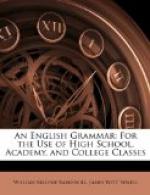285. All adverbs which have no function in the sentence except to modify are called simple adverbs. Such are most of those given already in Sec. 282.
[Sidenote: Interrogative.]
286. Some adverbs, besides modifying, have the additional function of asking a question.
[Sidenote: Direct questions.]
These may introduce direct questions of—
(1) Time.
When did this humane custom begin?—H. CLAY.
(2) Place.
Where will you have the scene?—LONGFELLOW
(3) Manner.
And how looks it now?—HAWTHORNE.
(4) Degree.
“How long have you had this whip?” asked he.—BULWER.
(5) Reason.
Why that wild stare and wilder cry?—WHITTIER
Now wherefore stopp’st thou me?—COLERIDGE
[Sidenote: Indirect questions.]
Or they may introduce indirect questions of—
(1) Time.
I do not remember when I was taught to read.—D. WEBSTER.
(2) Place.
I will not ask where thou liest low.—BYRON
(3) Manner.
Who set you to cast
about what you should say to the select
souls, or how
to say anything to such?—EMERSON.
(4) Degree.
Being too full of sleep
to understand
How far the unknown
transcends the what we know.
—LONGFELLOW
(5) Reason.
I hearkened, I know not why.—POE.
287. There is a class of words usually classed as conjunctive adverbs, as they are said to have the office of conjunctions in joining clauses, while having the office of adverbs in modifying; for example,—
When last I saw thy young blue eyes, they smiled.—BYRON.
But in reality, when does not express time and modify, but the whole clause, when..._eyes_; and when has simply the use of a conjunction, not an adverb. For further discussion, see Sec. 299 under “Subordinate Conjunctions.”
Exercise.—Bring up sentences containing twenty adverbs, representing four classes.
COMPARISON OF ADVERBS.
288. Many adverbs are compared, and, when compared, have the same inflection as adjectives.
The following, irregularly compared, are often used as adjectives:—
Positive. Comparative. Superlative.
well better best ill or badly worse worst much more most little less least nigh or near nearer nearest or next far farther, further farthest, furthest late later latest, last (rathe, obs.) rather
289. Most monosyllabic adverbs add _-er_ and _-est_ to form the comparative and superlative, just as adjectives do; as, high, higher, highest; soon, sooner, soonest.




